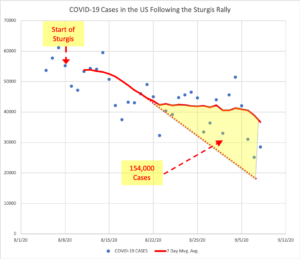I have been frustrated by the range of advice out there and the lack of clear justification, so I dug into the issues. In particular, I feel it is critical to understand the mechanism of transmission to minimize anxiety about the unknown and panic. As I have been saying, the young and healthy should chill out a bit on this and just exercise reasonable precaution. The old and infirm and those who care for them should take this very seriously. They account for most of the deaths. I consider the high risk group to be anyone over 70 and/or with any chronic disease, especially respiratory disease, and have included separate advice for them.
Basic Concepts
- The disease is not spread through the breathing of a sick person, only through secretions spread through direct contact, fomites (objects they have contaminated) or droplets emitted when they cough or sneeze. Asymptomatic people can only spread the virus if they contaminate a fomite with their saliva or mucous and someone else touches it and puts their fingers to the mouth, nose, or eyes.
- A sneeze or cough propels large droplets up to 6 feet and fine droplets (aerosols) up to 25 feet.
- New research (as in not even published yet) suggests novel coronavirus particles remain viable in aerosols for up to 3 hours and on a surface is almost gone in the first 24 hours, there can be some infectivity on some surfaces for up to 3 days. A leading virologist who reviewed this concluded it means the concern should focus on surfaces.
So, the trick is to avoid people who are actively coughing or sneezing and to avoid transferring the virus from contaminated people or fomites to your mouth, nose, or eyes. With those concepts in mind, I recommend minimizing time in crowds and using the following precautions to protect yourself and to protect others.
In general, you should not go out unless it is essential. The morning is the best time to shop because the stores and carts have been cleaned and the number of people who have touched the carts is minimal.
Active Coughing (note that sneezing is not commonly seen with Covid-19)
- If you unexpectedly need to cough or sneeze, do it into your elbow.
- If you have a persistent cough, stay home and, if you must be around people, minimize the duration and wear a mask (a standard surgical mask is sufficient). This is routine in many other cultures for people with any respiratory illness and should be here.
- If you encounter someone else who is coughing and they are using proper precautions, give yourself three or, if possible, six feet of clearance. If they are not using proper precautions or are coughing incessantly, get out of there.
- Minimize situations where you can’t distance yourself from someone who is coughing, especially air travel.
- If you need to be around someone who is coughing, wear a surgical mask. If it is a family member, there is almost no way to avoid contamination.
Direct Contact
- Lose the handshake.
This is a three-thousand-year-old ritual that probably served as a gesture of peace to demonstrate that neither party was carrying a weapon. This stuff is deadlier than a sword. And some alternate mode of contact, such as a fist bump, is just silly. We don’t need to touch everyone we meet. Learn from other cultures that have had to survive in crowded, often contaminated conditions. A head bow or a pleasant Namaste will suffice.
Fomites (Contaminated Surfaces)
- These pose the greatest threat given the long viability of the virus and are the primary mechanism of spread. They are the reason for all the handwashing and cleaning.
- Treat shared surfaces (objects likely to have been touched by others) with caution
- The greater the number of people who are likely to have touched it, the greater the caution
- If you expect to have prolonged contact with a shared surface outside the home, say the handle of a grocery cart, wipe it down with either disinfecting wipes with bleach (sorry, but those natural wipes have probably not been tested for this) or hand sanitizer (with at least 70% alcohol). Both have been shown to kill coronavirus within one minute.
- Try using your left (or right if you are a leftie) hand (again, learn from other cultures) or a barrier such as a tissue or glove, to touch heavily shared surfaces, especially those you can’t wipe down (i.e., door knobs, gas pumps, faucets,…)
- Try not to touch your face when you are out. If you must, use the back of your right hand (or left if you are a leftie).
- Use your right hand (left if leftie) to eat (at home) and to touch your face
- Wash hands after returning home
- Wash before eating or food prep
- Avoid food prepared outside your home that is:
- Uncooked
- Hand food
- Think of your phone as your iFomite. Wipe it down sanitizing wipe when you get home and try to handle it with your right hand.
High Risk Group
- Avoid going into crowds unless absolutely necessary.
- If you do, wear a surgical mask (a study of the flu virus found that fancier masks don’t appear to help much) and wash your hands immediately after leaving the public space.
- Minimize touching your face, do not do it at all while you are out in public spaces, and try to use the right and left hand approach discussed above.
- Visitors and caregivers for this population should wear masks and follow the precautions above scrupulously.



Thanks for all this, Bob.
If you have a specific question, let me know. I am also learning that no one sees what you post on Facebook if it is not getting likes, so click away. In the meantime, stay safe.
Namaste, Dr. Bob! And thanks for the information. Facts about this illness seem to be in short supply…
Glad this is helpful, big dog. Let me know if you have questions. Stay safe.
All great information, but for we gauche lefties, maybe include suggestion to reverse to dominate hand.?
I just thought of that during my last edit. Sorry about that. Will edit. Thanks for following!
Thank you cuz! Diana just linked me to this
Glad you like it, Dan. Stay safe.